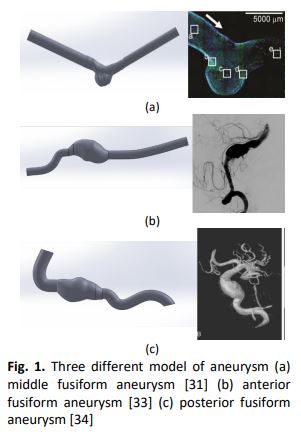Temperature Variation with Hemodynamic Effect Simulation on Wall Shear Stress in Fusiform Cerebral Aneurysm
DOI:
https://doi.org/10.37934/arfmts.95.2.4054Keywords:
Aneurysm, middle cerebral artery, fusiform, wall shear stress, hypertensionAbstract
A cerebral aneurysm is the dilation of an arterial wall and mostly occurs at the weak point in the arterial circulation in the brain. Approximately 85% of aneurysms are in the anterior circulation, predominately at junctions, or bifurcations along the circle of Willis. Several studies have been conducted by researchers to analyse the blood flow characteristic and flow on the aneurysmal wall, however, there are small numbers of research focus on the fusiform aneurysm and the effect of temperature on the blood flow inside the aneurysm. Thus, this study aims to analyse the body temperature effect on hemodynamic parameters in the fusiform aneurysm. Three different models of the fusiform aneurysm based on patient-specific geometries have been developed and simulated. The computational Fluid Dynamics (CFD) method was imposed in this study to analyse the effect of hemodynamic variables on the different body temperatures by analysing the Wall Shear Stress (WSS) and Oscillatory Shear Index (OSI) at the fusiform aneurysmal wall. The result shows that the WSS values fluctuate with the temperature variations and were observed lowest low at the anterior fusiform aneurysm. The OSI indicates similar results for each physiological condition with the variation of temperature. The high value of WSS and low value of OSI increase the possibility of an aneurysmal wall being ruptured.
Downloads






























